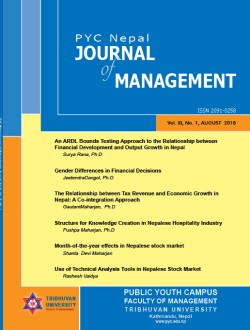An ARDL Bounds Testing Approach to the Relationship between Financial Development and Output Growth in Nepal
DOI:
https://doi.org/10.3126/pycnjm.v11i1.35914Keywords:
Financial Development, Output Growth, Co-integration, ARDLAbstract
This paper examines the relationship between financial development and output growth in Nepal over 42 years of period from mid- July 1975 to 2017 using ARDL bounds testing approach to co-integration. The study uses natural logarithm of per capita real GDP as a proxy of output growth and means removal average of broad money (M2) to GDP ratio and domestic private credit to GDP ratio as a proxy of financial development indicator. The results of ARDL bounds test show that financial development and output growth in Nepal is co-integrated over the study period. The study results demonstrate that financial development in Nepal leads to output growth in the long-run. However, the study fails to detect any impact of financial development on output growth in Nepal over the short-run. Based on long run results of this study, it can be concluded that development of financial sector in Nepal can stimulate long-run output growth. Thus, considerable efforts should be paid on promoting the development of the financial sector that contributes significantly to achieve long-run output growth.
Downloads
Downloads
Published
How to Cite
Issue
Section
License
© Public Youth Campus

